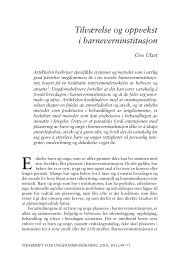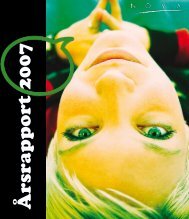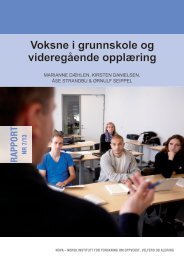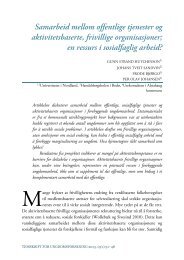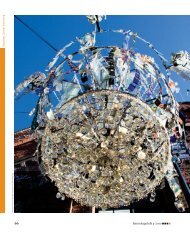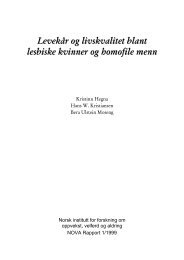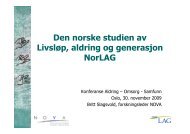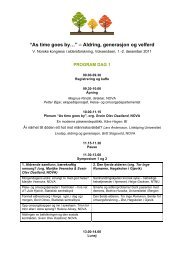Parents' socioeconomic status and children's academic ... - Nova
Parents' socioeconomic status and children's academic ... - Nova
Parents' socioeconomic status and children's academic ... - Nova
You also want an ePaper? Increase the reach of your titles
YUMPU automatically turns print PDFs into web optimized ePapers that Google loves.
Table 2: Pupils’ achievement (in per cent) in case <strong>and</strong> control group<br />
Norwegian Maths English<br />
Score Case Control Case Control Case Control<br />
Very Good 24 28 21 25 26 31<br />
Good 71 69 62 69 65 64<br />
Fair 5 3 17 6 9 5<br />
N 345 103 347 103 348 104<br />
To compare performances of the pupils in each of the three subjects, in the<br />
two samples, a ‘population proportion’ test was used, with P1 for the case<br />
sample <strong>and</strong> P2 for the control group. Table (3) summarizes the result of the<br />
comparison. The confidence interval limits for the differences in the three<br />
categories of grades pass through the zero point for the three subjects, except<br />
for the ‘Fair’ category for maths. Hence, differences in this category are<br />
significant. The sign of ‘D’ is positive, indicating that pupils in the control<br />
group do better then their peers in the case sample. I conclude that there is<br />
no difference in pupils’ performance in the subjects Norwegian <strong>and</strong> English,<br />
while the difference between the two samples is significant in maths.<br />
Table 3. Comparison of pupils’ results. Between the case sample <strong>and</strong> control group<br />
Norwegian Maths English<br />
Very<br />
Good Good Fair<br />
Very<br />
Good Good Fair<br />
Very<br />
Good Good Fair<br />
(D=P 1 -P 2 ) -0.04 0.01 0.02 -0.04 -0.07 0.11 -0.05 0.01 0.04<br />
Se(D) 0.05 0.05 0.02 0.05 0.05 0.03 0.05 0.05 0.05<br />
95% CI (-0.1,<br />
0.1 )<br />
(-0.1,<br />
0.1 )<br />
(0.0,<br />
0.1 )<br />
(-0.1,<br />
0.1 )<br />
(-0.2,<br />
0.0 )<br />
(0.1,<br />
0.2 )<br />
(-0.2,<br />
0.1 )<br />
(-0.1,<br />
0.1)<br />
(0.0,<br />
0.1 )<br />
In addition to scores in each of the three subjects, aggregates of the scores in<br />
the three subjects are also used. Figure (1) shows the distribution of the total<br />
for both the case sample <strong>and</strong> the control group. The total ranges from five to<br />
seventeen in the control <strong>and</strong> four to sixteen in the case sample.<br />
– Parents’ <strong>socioeconomic</strong> <strong>status</strong> <strong>and</strong> children’s <strong>academic</strong> performance – 25





